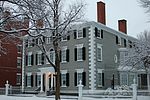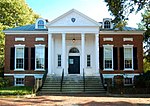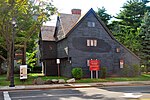Cotting–Smith Assembly House
1782 establishments in MassachusettsEssex County, Massachusetts Registered Historic Place stubsHistoric district contributing properties in MassachusettsHouses completed in 1782Houses in Salem, Massachusetts ... and 5 more
Houses on the National Register of Historic Places in Essex County, MassachusettsNRHP infobox with nocatNational Register of Historic Places in Salem, MassachusettsPeabody Essex MuseumUse mdy dates from August 2023

Located in Salem, Massachusetts and owned by the Peabody Essex Museum the Cotting–Smith Assembly House was built in 1782 and is located at 138 Federal Street in the Federal Street District. Built as a Federalist Clubhouse in which balls, concerts, lectures, and other events might be held. George Washington attended a dance here. The original architect is unknown, but the house was later remodeled by Samuel McIntire for use as a private residence. The house is in the Federal style and is listed in the National Register of Historic Places. The building can be rented for special events.
Excerpt from the Wikipedia article Cotting–Smith Assembly House (License: CC BY-SA 3.0, Authors, Images).Cotting–Smith Assembly House
Federal Street, Salem
Geographical coordinates (GPS) Address Nearby Places Show on map
Geographical coordinates (GPS)
| Latitude | Longitude |
|---|---|
| N 42.52075 ° | E -70.903833333333 ° |
Address
Federal Street 138
01970 Salem
Massachusetts, United States
Open on Google Maps











